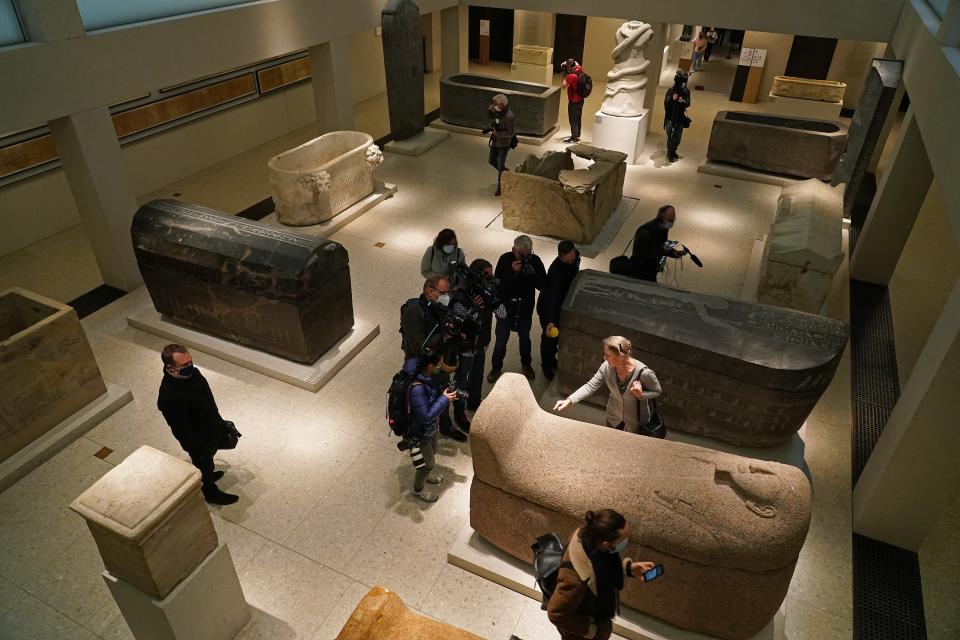Conspiracy theorists ‘linked to attack' on Berlin museum, which they claim is centre of ‘global satanism’

A conspiracy theory propagated by a celebrity chef has been linked to “one of the most extensive attacks on works of art and antiquities” in contemporary Germany, which had been kept secret by officials.
More than 60 artefacts and artworks were vandalised at Berlin’s Museum Island complex – a UNESCO World Heritage site – on 3 October, German police admitted on Wednesday, following an investigation by Die Zeit newspaper and Deutschlandfunk radio station.
An oily liquid was smeared across 63 exhibits at the Pergamon Museum, the Alte Nationalgalerie and the Neues Museum, said the deputy director of Berlin's state museums, Christina Haak.
There was no thematic link between the targeted works, which reportedly included Egyptian sarcophagi, stone sculptures and nineteenth century paintings , and “no pattern is discernible” to the perpetrator's approach, Ms Haak said.
But while a motive remains unclear, German media reported that the Pergamon is subject to a conspiracy theory which claims it is the centre of the “global satanic scene” and “the source of all evil”.
One proponent of this theory is Attila Hildmann, a celebrity chef turned far-right conspiracy theorist, who adheres to QAnon beliefs and claims Ms Merkel – whose residence lies just across from the Pergamon – is among world leaders preparing a coronavirus vaccine in order to commit genocide.
In August and September, when the museum was closed, he claimed the museum is the “throne of Satan”, where satanists and “corona criminals … make their human sacrifices at night and desecrate children!”
His claims reportedly involve the museum’s world-famous reconstruction of the ancient Greek Pergamon Altar.
Deutschlandfunk reported that in one post on 23 August, he told his 100,000 followers: “On Saturday the holy of holies of these Satanists must be torn down! The Pergamon Museum, the Baal Temple! That is the source of all evil here on ‘earth’!”
Felix Huesmann, a journalist specialising in the far-right, tweeted: “Of course, Attila Hildmann didn't come up with this crap. In recent months it has been distributed on Telegram (also by [singer-songwriter] Xavier Naidoo), but has been one of the narratives of the conspiracy-esoteric scene for years.”
The coronavirus pandemic, and resulting economic fallout and restrictions on liberty, has stimulated the spread of conspiracy theories in an alarming fashion, with the head of the UK’s counter-terror police warning MPs last month of a “growing climate of extremism”.
On Tuesday, Hildmann posted a link to Deutschlandfunk’s investigation into the attack on the museums, which he captioned: “Fact! It is the throne of Baal.”
However, police refused to comment on the speculation that conspiracy theorists may be involved. There is no suggestion that Hildmann is in any way linked to the incident.
Senior Berlin police official Carsten Pfohl said investigators were probing in “in every direction” but that in the absence of an apparent connection between the targeted objects or “a self-incriminating letter or anything like that, we have to assume for now that the motive is completely unclear”.
Police said they had kept the incident a secret until it was revealed by the media two weeks later out of “tactical considerations related to the investigation”.
The attack took place between 10am and 6pm on 3 October – the 30th anniversary of reunification between East and West Germany – when some 3,000 people visited Museum Island, Mr Pfohl said.
Complicating investigators' efforts, most of that day's tickets were sold on site and only 1,400 personalised tickets had been booked in advance. All who purchased in the latter fashion have been contacted by email to ask whether they noticed anything untoward.
Police said they had watched hours of surveillance camera footage but hadn't found any obvious sign of anyone applying the liquid.
The liquid was oily but not corrosive, said Friederike Seyfried, the director of Berlin's Egyptian collection, which is housed in the Neues Museum. She would not give more specific details of the colourless fluid, citing the ongoing investigation.

However, Die Zeit described the vandalism as “one of the most extensive attacks on works of art and antiquities in the history of post-war Germany”.
And Deutschlandfunk reported that: “Anyone who thinks that the Berlin museums got off lightly is underestimating the scope of this attack – not only because the liquid could also have been a caustic acid. In terms of its size, this is one of the largest iconoclastic attacks in post-war Germany."
Germany's culture minister Monika Gruetters strongly condemned the damage to the artworks.
“There is justified hope that the damage can be repaired,” Ms Gruetters said, adding that Berlin's state museums once again need to answer questions over their security precautions – following the audacious theft of a 100kg Canadian coin from the Bode Museum in 2017.
Ms Haak said the museums’ security systems are constantly being reviewed and officials are considering how to improve them, but that “100% security for the objects would mean in principle having to withdraw them from public view”.
Mr Pfohl said that the damage had been discovered by museum staff and that officials weren’t aware of any threats, adding that attacks on artefacts in museums using liquids have taken place in other countries.
In 2018, two Bulgarian women were arrested after smearing what they claimed was holy oil and myrrh on exhibits at Athens’ National Historical Museum.
They reportedly told police that they did so “because the Holy Scripture says it is miraculous”.
Additional reporting by AP
Read more
Conspiracy theories mean vaccine ‘might not be enough’ to end pandemic
Trump refuses to condemn QAnon conspiracy theorists
The onward march of the nationalist far-right across Europe is over

